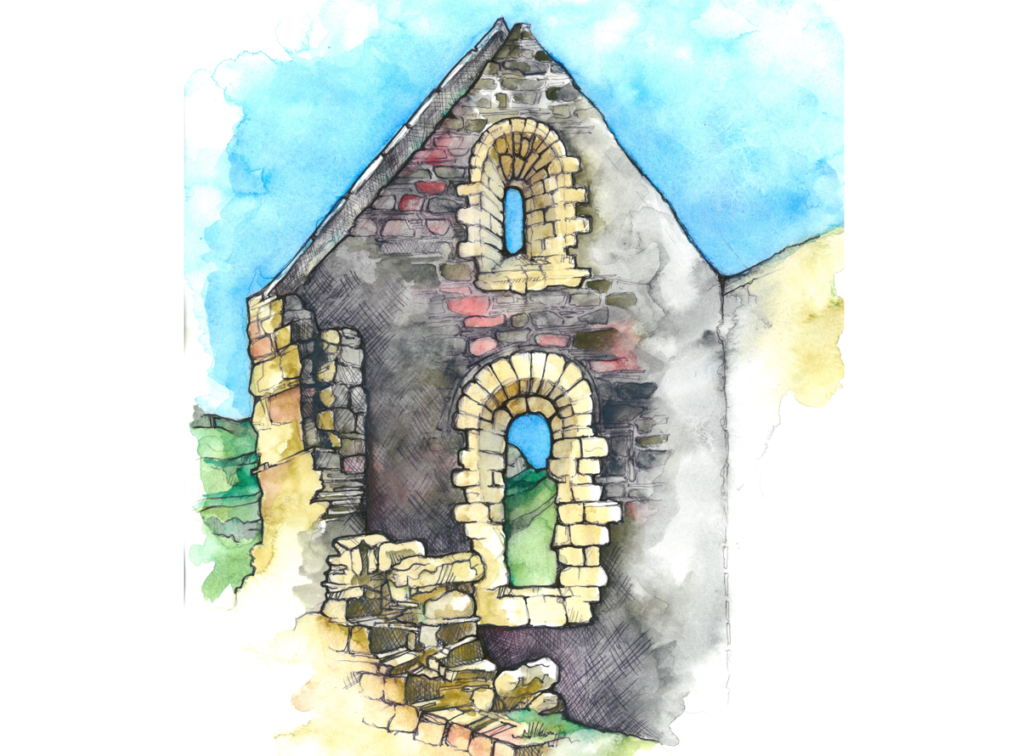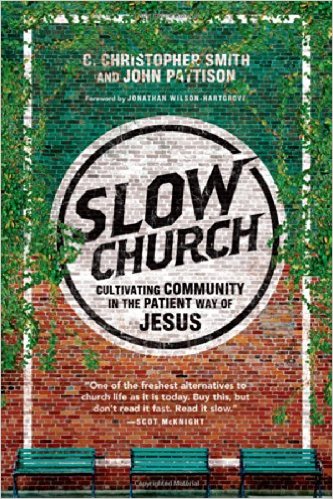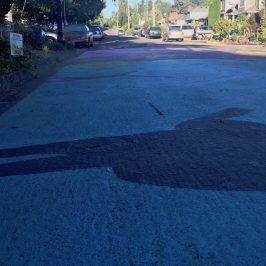
I recently had the privilege of editing a manuscript for my friend, the artist and writer Kari Gale. Kari writes a lot about pilgrimage and her forthcoming book describes the ten weeks she spent on Iona, a small island off the western coast of Scotland that has become nearly synonymous with Celtic Christianity.
Though the island measures only one by three miles—an area smaller than my town of Silverton, Oregon (pop. 10,000)—Iona was the heartbeat of monastic life in Scotland and northeastern England for hundreds of years. It was the adopted home of Saint Columba, who arrived from Ireland in A.D. 563, perhaps as penance for taking up arms as a monk. Over the next three decades, Columba oversaw the foundation of some sixty monasteries in Scotland.
The Book of Kells, the famous illuminated gospels dating from around 800, was probably begun on Iona. Also familiar are the high stone crosses, which some scholars believe first came into popular use there.
In one passage in her manuscript, Kari recalls sitting on the rock ruins of a medieval nunnery and feeling welcomed into the ongoing spiritual life of a community that hasn’t been officially active for hundreds of years. I could easily imagine the women who for generations had quietly gone about their lives of daily prayer, work, and worship in that place. The spirit of those nuns—as well as the monks and laypeople of ancient Iona—seems to have permeated the island’s very soil and stones.
Which got me thinking: What is the half-life of holiness? Does holiness accumulate in a place over time, and can it be felt by the people who live or visit there, even many years later? And is this part of what Celtic Christians meant by “thin places”—those sites where the membrane between earth and heaven, the visible world and the invisible, seems especially porous?
My New Project
As I mentioned in my last post, I am working on a book project about the re-enchanting of ordinary life. Prior to finding clarity on the project, there were weeks when I sensed I was writing “around” a central theme—in blog posts, in my journal, or on whatever scrap of paper was close at hand—but I couldn’t articulate what that theme was. Reading the above passage in Kari’s manuscript flipped a switch for me. I wrote down a string of questions I wanted to explore further. Those became the book’s superstructure and, eventually, a chapter-by-chapter synopsis.
What animates the whole project is a hunch that we still live in a God-saturated world. Celtic Christians believed that even the most common tasks (washing dishes, milking the cow, baking bread, etc.) were performed with the help of the Trinity and in the company of angels. A walk to and from the fields was an opportunity to talk to God with the intimacy of Adam and Eve in the Garden.
We too can meet God in the “thin places” of our everyday lives. This is the spirituality that animates Slow Church within the day-to-day stuff of life. My book may start in Ireland and Scotland but it moves progressively closer to home. The wilderness, the neighborhood, the Church, our families, our bodies, the borderlands of our own souls: if we are attentive, these are seams through which we glimpse firsthand the presence of the God who still pervades and sustains all things.
The Half-Life of Holiness
My new book isn’t about Celtic spirituality, though it is profoundly informed and inspired by it. Learning about my spiritual ancestors—not to mention my actual ancestors (the name “Pattison” can be traced back to a Gaelic kingdom that included Iona)—has given my project clarity and momentum and enthusiasm.
For example, Kari’s simple, quiet, lovely recollection of the nunnery spurred weeks of my own writing. My initial question, “What is the half-life of holiness?”, was stuck in my head for weeks. Contemplating it invigorated my thinking about place, time, impact, and the Church…so much so that I had created separate pages in my pocket notebook to capture the stream of questions, quotes, and thoughts on those subjects.
To give you a sense of where the book is going—and to reveal a little about my own process—here are some of those notes I made in my pocket notebook. (Pretend they are handwritten.) Each represented a trail to be explored in more detail later:
Place
- I’m fascinated by the idea that Spirit-filled care for a particular place leaves a trace. It’s the fingerprint of God left by Christians who see themselves as the hands of God on earth. What’s just as thrilling is the belief that what is true for Iona is possible for my own community: Silverton as a thin place.
- Wendell Berry wrote in one of his poems: “There are no unsacred places; / there are only sacred places / and desecrated places.” Those of us who pledge allegiance to Jesus are invited to join God in the re-sacralization of our places.
- This includes our homes, our neighborhoods, our common spaces, our places of business and education, and everything in-between. It includes people as well as the built environment. It also includes the water, air, soil, and rocks, and everything that lives in, on, and above them.
- Sometimes our job is to actively cultivate those places into a new flourishing, reclaiming our Edenic vocation as thoughtful stewards of Creation. At other times our role is to exercise self-control and to leave well enough alone.
Time
- We are engaged in work we didn’t start and won’t see the end of. God was here before us and will be here after.
- We know the past, hope for the future, and try to live faithfully in and to the present. One of our hopes is that people will come after us who want to love our places as much as we did.
- Emily Dickinson:
Forever – is composed of Nows –
‘Tis not a different time –
Except for Infiniteness –
And Latitude of Home –
- “Forever…is composed of Nows…” This doesn’t diminish the importance of the present moment but rather sanctifies it.
- This reminds me of the distinction made in Greek between chronos time and kairos time. Chronos is chronological time, kairos is the right or opportune time. (Richard Rohr describes kairos as “deep time.”) Is chronos time contained within kairos time, is it the other way around, or are they both contained in each other? Can time be a thin place?
Impact
- Taking the long view is a reminder to cease my striving, slow down, and, when necessary, to submit my desire for “impact” and “legacy” to the requirements of the person and place right in front of me.
- Wendell Berry (again):
Suppose we did our work
like the snow, quietly, quietly,
leaving nothing out.
Church
- The nuns, monks, and laypeople on Iona—as well as the saints that were their traveling companions—are part of a “great cloud of witnesses” (Hebrews 12:1).
- I want to take this as an invitation to learn about the “saints of Silverton.” These are the mostly anonymous men and women who loved well a place I hope to call home until I’m called Home.
- Life for Celtic Christians was an ongoing conversation with the supernatural. I’ve seen this dismissed as quaint superstition even from some spiritual writers I respect. That seems arrogant. What if God, in God’s generosity, meets us in the times, places, and ways in which we expect God to meet us? Some Christians in the U.S. today meet God in a great worship set, in the speaking of tongues, or by rehearsing the evidence that demands a verdict. For Celtic Christians, Christ, Mary, and the saints were present realities—and I have no reason to doubt them.
- RNS headline: “Author of Slow Church believes in ghosts”
I also wrote down “The Columba Option,” though I doubt it will get as much traction as the original.
Thankfully, we don’t always have to wait hundreds of years to experience the impact of someone’s quiet faithful presence. In Part 2 of this piece, I’ll introduce you to my friend James Helms, whose family has been working with neighbors to weave a fabric of care in northeast Portland. But, as we will see—and as James would be the first to tell you—he and his family are part a continuum of faithfulness that began long before they moved into the neighborhood.
Image Credit: A painting of the Iona nunnery, by Kari Gale. From her forthcoming book and used with permission.




3 Responses
sara
Finally catching up, and I am SO excited about this book and these questions. I have been wrestling with many of them myself/we have been wrestling as a family. I think I have some good push-back for you that I’ve run into here if you’re looking for some more questions to wrestle with as you write.
slowchurchadmin
That sounds great, Sara!
Kari
Hey you! Just saw the link to this pending on Facebook! (I have my settings set to approve anything I’m tagged in somehow) I wondered if you had posted it! I love that you divvied it up to 2 posts and I’m so excited to see what happens with this book and how it plays out in your wonderful writing. My Iona book should finally be published next week and I’ll send out an announcement. I am going to have a small book-release party sometime in September and I’d love for you to come. Hope your August is going splendidly!!